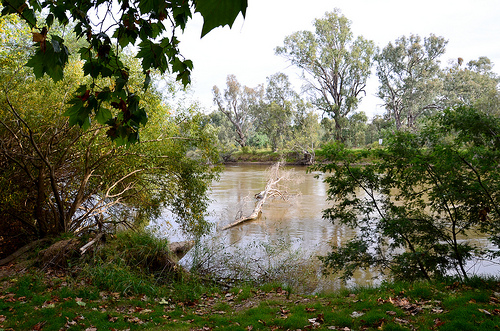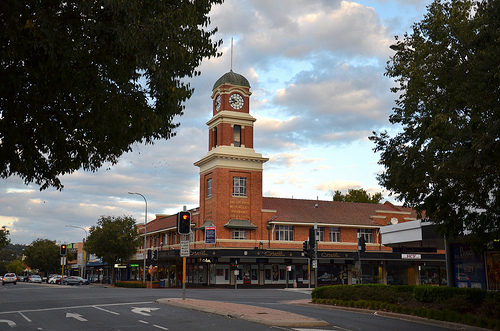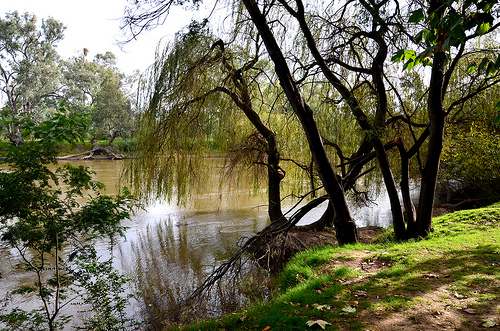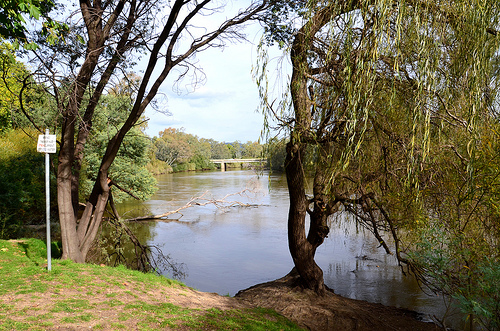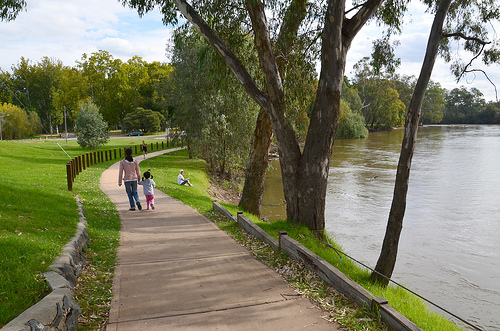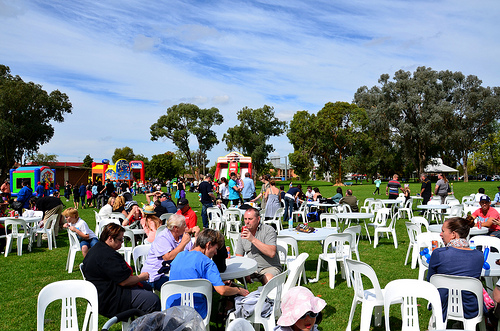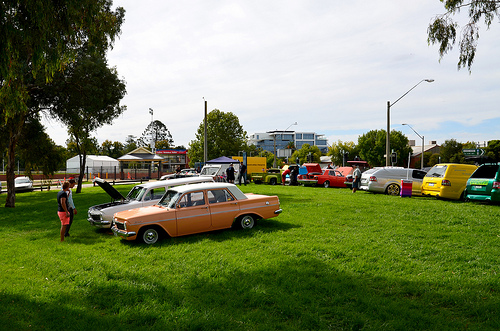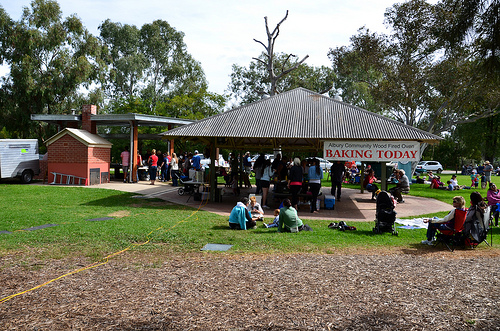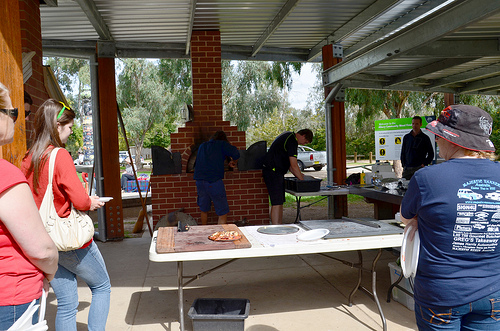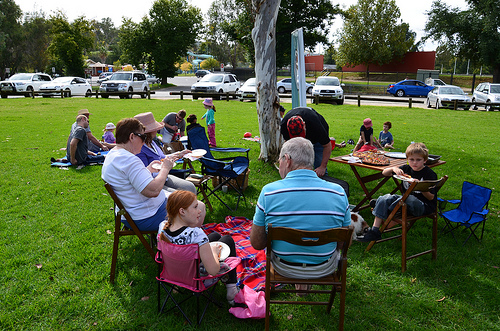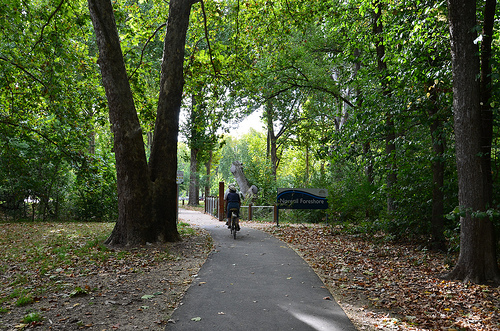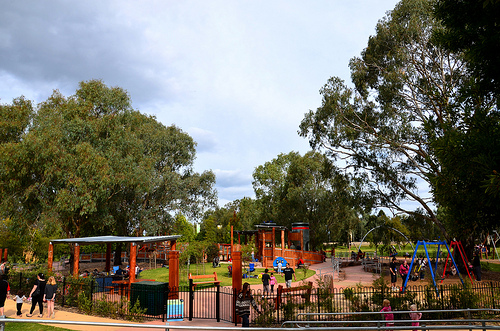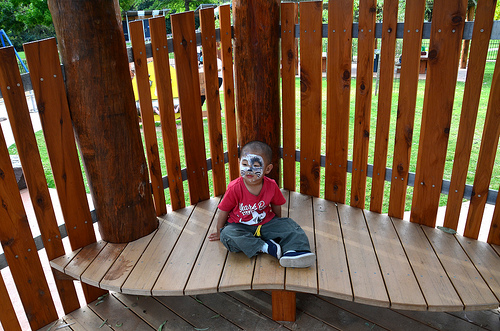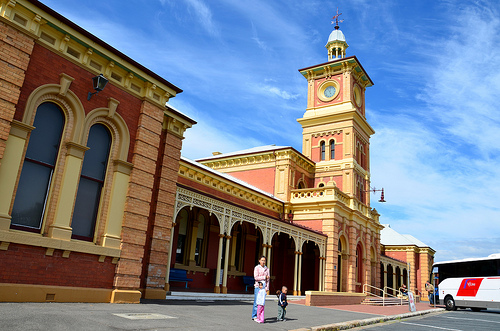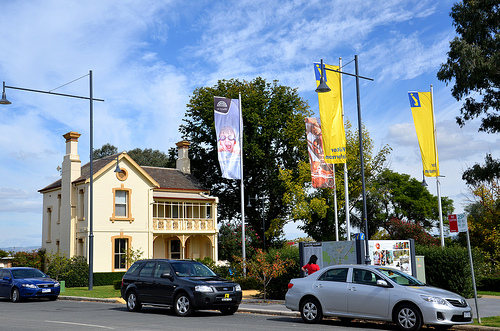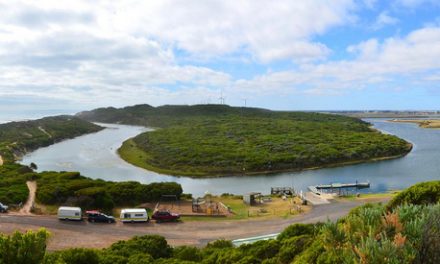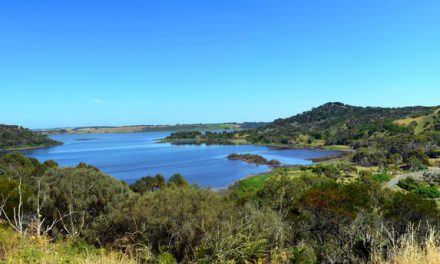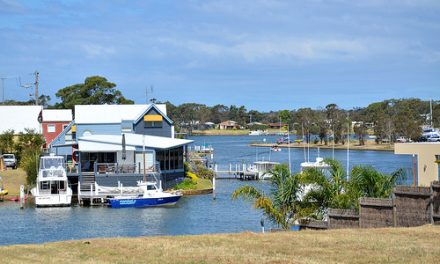
View of Albury City from Monument Hill
The area was occupied by the Wiradjuri people for thousands of years before European settlement. The explorers Hamilton Hume and Captain William Hovell led an expedition in October 1824 to find new grazing land and map NSW’s western rivers. They crossed the Murray River at Albury on 16 Nov 1824. On the next day, Hovell carved the words “Hovell NovR17/24” into the trunk of a tree to mark the crossing place. Within a few years, the crossing place near “Hovell Tree” had become very popular. A police station and general store had opened and squatters began to move into the district. A survey for a town was commissioned in 1838 by Assistant Surveyor Thomas Townsend who proposed the settlement be named “Bungambrewatha” after the area’s aboriginal name. When his plan was eventually approved on 13 April 1839, the name was changed to Albury, said to be named after a village in Kent, England which it resembled.
By 1847, the Albury settlement included two public houses and a handful of huts, a police barracks and blacksmiths. When Victoria separated from NSW in 1851, Albury became a frontier town and a customs post between the two colonies. Albury was at this time starting to grow substantially with German-speaking immigrants using the area to grow grapes for wine. Albury boasted by the 1870s a butter factory, flour mill, wineries and locally brewed cider and soft drinks.
Albury’s proximity to Wodonga has spurred several efforts to achieve some kind of municipal union. In 1973, under Whitlam Federal government’s grand plans to decentralize uncontrolled growth away from Australia’s large coastal cities, Albury-Wodonga was selected for conversion into a major inland city. The Federal government compulsorily purchased large areas of surrounding farmlands and enticed some industries to move there. A certain amount of population movement did result but was well below projection.
Murray River
The Murray River creates a natural border between NSW and Victoria and is the world’s 16th longest river at 2,995 km from its source in the Kosciusko National Park. It is fed by several rivers on its journey from the Australian Alps. The main feeding rivers are the Darling and Murrumbidgee Rivers.
The river’s aboriginal name was Millewa. It was first discovered at Albury by European explorers Hamilton H. Hume and William H. Hovell on 16 November 1824. They marked on their maps “Crossing Point” and named it the Hume River. On the next day, they inscribed a tree by the riverbank before continuing their journey south to Westernport in Victoria.
In 1829, explorer Captain Charles Sturt discovered the Hume River downstream at its junction with the Murrumbidgee River. Not realizing it was the same river, he named it the Murray River after Sir George Murray. Both names persisted for some time, Hume falling into disuse eventually in favour of Murray.
The Wagirra Trail, a Wiradjuri word meaning “step on the ground“, is a planned 70 km of trail along the Murray River, connecting Wonga Wetlands with the Hume Weir. Currently, the Murray River already connects a string of riverside parks including Hovell Tree Park, Noreuil Park, Australia Park and Oddies Creek Park. These parks are extremely popular for bike riding, barbecues, picnics and general relaxing.
There are 2 places along the Murray River, the Wonga Wetlands and Mungabeena Reserve, which could be very attractive and that I have missed out in this trip due to time constraint. The Wonga Wetlands in particular is a sanctuary for birdwatchers, field naturalists, photographers and bushwalking enthusiasts. An ecosystem of lagoons and billabongs, Wonga is home to 154 identified bird species, a Wiradjuri campsite and ancient river red gums. The wetlands incorporate 7 lagoons covering around 80 hectares on the Murray River floodplain, 3 km of walking paths and picnic and barbecue facilities.

Birds at Oddies Creek Park along the Murray River
Hovell Tree Park
Located at the corner of Wodonga Place and Hume Street, this is the place where the explorers Hume and Hovell had carved their names into the trunks of two trees on 17 November 1824. Hume’s tree was destroyed by fire but Hovell’s tree still stands today.
The park was also where the town’s first general store and wharf were located. Just south of the park, on Wodonga Place is the Turks Head Hotel – the first pub and inn in Albury and once the most popular place in town. This park is now home to the Community Wood Fired Oven and a popular children’s playground where my kids spent considerable time.
Prior to making the trip to Lake Hume, I had been checking Albury-Wodonga tourism sites for places to visit and activities during the Easter period. Hence, I was aware that the City Central Church was holding a big Family Fun Day at Hovell Tree Park on Easter Sunday.
Activities include an Easter Egg Hunt, jumping castles, clowns, balloon sculptures, free face painting and sausage sizzles. The highlight is definitely face painting, which my kids enjoyed immensely.
Also at Hovell Tree Park were two other activities – the Community Wood Fired Oven’s Baking Day and Majestic Vanners Australia’s Easter Van-In 2012. Classic vans from the 60s up to modern day were displayed at the park’s perimeter off Wodonga Place. Having seen the Altona Classic Car Show, I was spoilt so this exhibition did not interest me much.
Community Wood Fired Oven
The Community Wood Fired Oven is located in Hovell Tree Park by the banks of the Murray River and in the shade of an old river gum – a place to come together to cook, share, learn and eat. The idea came from Albury City Council’s cultural development officer Narelle Vogel who saw a picture on a Canadian website. A $15,000 State Government grant kicked off the project and wood-oven “guru” Alan Scott was brought in to help design and build it. The Oven was launched in October 2006. The idea of building the oven was not without its critics who think this was a waste of money.
The Oven is fired every second Sunday for free community use. It is open for baking from 3-8 pm from Oct-Mar and 11am-4pm from Apr-Sep. The Oven is lit the night before a bake. The Oven Coordinator clears out the ash and prepares the oven ready to take pizzas, bread and any other food such as roast meat, vegetables, scones, pies and quiches. The temperature slowly drops during the day. Pizzas and Lebanese bread should be cooked early in the bake (300-400ºC), then bread and finally roasts, cakes and biscuits when the temperature drops to around 275ºC after 3 hours. The Oven Coordinator is available during the bake to offer advice and guidance.
Neighbours and strangers sit together and talk about the food they are cooking, their family and other community matters. There is a real engagement that happens around the oven. The Oven has won a national award recognizing the significant role it plays in bringing neighbours and communities together. Apart from attracting about 100 people to its monthly bake, it is also used for larger community events such as Harmony Day and can be hired for private functions.
There is a new community wood fired oven at San Remo (Bass Strait) that is operational only this year. If there is one in Hobsons Bay or Melbourne, I will love to use it.
Noreuil Park
Noreuil Park lies on the banks of the Murray River, less than 1 km from Albury CBD and is one of the city’s most popular destinations. The Wagirra Trail follows the river along the foreshore, which is a popular swimming spot in Albury. The canopies of the regal plane trees provide shade for multiple barbecue and picnic sites throughout the park. There is also a River Deck Cafe that is open during the warmer months.
The name Noreuil came from an old battlefield village in the Pas-de-Calais region of northern France. Soldiers of the Albury Battery, part of the 5th Brigade, helped capture Noreuil from the German Army on 2nd and 3rd April 1917. In 1919, Albury mayor Alf Waugh convinced the city council to name a new riverside park after Noreuil as a tribute to the soldiers’ actions. “Noreuil was the place where the battery covered themselves with imperishable glory,’’ he said at the time.
Oddies Creek Park
Located off Wodonga Place, Oddies Creek Park is adjacent to the Noreuil Park Foreshore and the Wagirra Trail. Here a new $922,000 playground opened in August 2011. This playspace is designed by renowned landscape architect Mary Jeavons and constructed by Albury Council’s all-aboriginal Wagirra Trail crew.
This fully-fenced playground is designed for children from babies to teenagers with features to stimulate physical, social and imaginative play experiences. Highlights include planting of trees and shrubs to create tunnels and a natural cubby space, a small amphitheatre for creative play, rockers, a large climbing net, an observation deck, a multi-directional giant swing and a 30m flying fox. Fully landscaped, the area is an ideal spot for a family day out. It is surrounded by green open space, is only metres from the Murray River and has BBQ facilities and amenities.
Albury Botanic Gardens
Albury Mayor Alderman William Jones opened the Albury Botanic Gardens with the planting of an English Elm tree in 1887. For the past 130 years, the Albury Botanic Gardens has graced the western end of Albury’s CBD. While the trees have matured and the layout has been modified, the Gardens has lost none of its beauty and charm and to this day, remains the city’s “jewel in the crown“.
Sprawling over 4 hectares, the gardens feature an impressive collection of more than 1000 native and exotic plant species. Around 250,000 people visit the gardens each year, many coming for a picnic, a gentle stroll or the ambience. School children visit the botanic gardens to learn about plants and the local environment.
Work continues on regeneration and replacement of species that have reached the end of their life-span, in particular the elm trees in Elm Avenue. With the help from the Friends of the Botanic Gardens, Albury City is planning a range of improvements including the creation of a children’s garden.
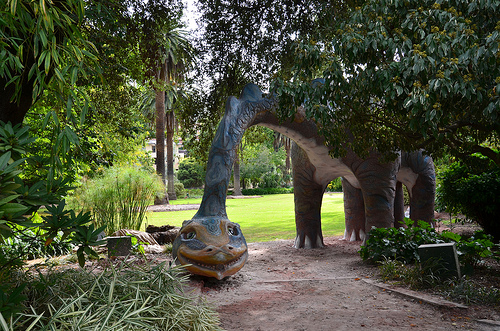
Dinosaur in the Children’s Garden
Albury Train Station
The Albury Train Station (photos) is indisputably the grandest railway building outside of Melbourne or Sydney. This magnificent Victorian structure represents both the formal shaking of hands between the two colonies of NSW and Victoria and a monument to their continuing separation and differences.
Designed and constructed under the supervision of John Whitton, Albury Station was opened on 3 Feb 1881, together with the opening of the Gerogery to Albury extension of the Great Southern Line from Sydney. At that time, the Victorian line was complete as far as Wodonga and a trip between Sydney and Melbourne required a coach connection to cross the Murray River.
On 14 June 1883, the NSW line was joined to the Victorian network via a temporary wooden railway bridge across the Murray River. Although the rail link between the two states was now complete, all passengers and goods traffic still had to change in Albury and switch over to another train because the two competitive states insisted on retaining different rail gauges. NSW had the standard gauge of 143.5 cm while Victoria had the broad gauge of 160 cm. This interstate intransigence required a platform long enough to accommodate two full-length trains, which led to the building of the longest (and arguably the most impressive) platform in the country, measuring over 455 metres of Victorian wrought iron beauty. The states could not initially agree which should be the transfer point so they had an expensive and attractive iron lattice bridge sent from Scotland which accommodated both gauges. The bridge is still standing astride the Murray and is in daily use.
The standard gauge line was extended to Melbourne’s Spencer Street Station (now Southern Cross) in 1962, with the running of the first non-stop freight service between Melbourne and Sydney in January and the first non-stop passenger train, the Southern Aurora, on 16th April of that year. Broad gauge trains from Melbourne continued using the back (dock) platform but had ceased operating in 2008 as the broad gauge line was converted to standard gauge.
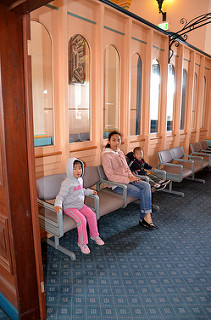 |
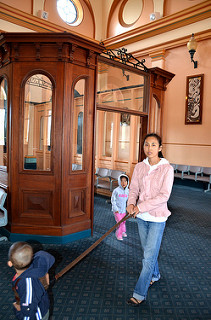 |
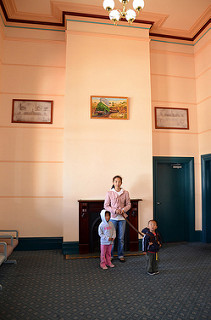 |
You can appreciate the station’s beauty by walking the whole length of the magnificent platform, the longest undercover platform in the southern hemisphere. Stroll through the original waiting areas with ornate pressed metal ceilings showcasing superb craftsmanship of a bygone era. Located across the road from the station is the Station Master’s residences which now houses the Albury’s Visitor Centre.

